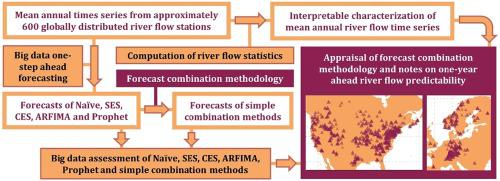当前位置:
X-MOL 学术
›
J. Hydrol.
›
论文详情
Our official English website, www.x-mol.net, welcomes your
feedback! (Note: you will need to create a separate account there.)
Hydrological time series forecasting using simple combinations: Big data testing and investigations on one-year ahead river flow predictability
Journal of Hydrology ( IF 5.9 ) Pub Date : 2020-11-01 , DOI: 10.1016/j.jhydrol.2020.125205 Georgia Papacharalampous , Hristos Tyralis
Journal of Hydrology ( IF 5.9 ) Pub Date : 2020-11-01 , DOI: 10.1016/j.jhydrol.2020.125205 Georgia Papacharalampous , Hristos Tyralis

|
Delivering useful hydrological forecasts is critical for urban and agricultural water management, hydropower generation, flood protection and management, drought mitigation and alleviation, and river basin planning and management, among others. In this work, we present and appraise a new methodology for hydrological time series forecasting. This methodology is based on simple combinations. The appraisal is made by using a big dataset consisted of 90-year-long mean annual river flow time series from approximately 600 stations. Covering large parts of North America and Europe, these stations represent various climate and catchment characteristics, and thus can collectively support benchmarking. Five individual forecasting methods and 26 variants of the introduced methodology are applied to each time series. The application is made in one-step ahead forecasting mode. The individual methods are the last-observation benchmark, simple exponential smoothing, complex exponential smoothing, automatic autoregressive fractionally integrated moving average (ARFIMA) and Facebook's Prophet, while the 26 variants are defined by all the possible combinations (per two, three, four or five) of the five afore-mentioned methods. The findings have both practical and theoretical implications. The simple methodology of the study is identified as well-performing in the long run. Our large-scale results are additionally exploited for finding an interpretable relationship between predictive performance and temporal dependence in the river flow time series, and for examining one-year ahead river flow predictability.
中文翻译:

使用简单组合的水文时间序列预测:一年前河流流量可预测性的大数据测试和调查
提供有用的水文预报对于城市和农业水资源管理、水力发电、防洪和管理、减轻和缓解干旱以及流域规划和管理等至关重要。在这项工作中,我们提出并评估了一种新的水文时间序列预测方法。这种方法基于简单的组合。评估是使用一个大数据集进行的,该数据集由大约 600 个站点的 90 年平均年河流流量时间序列组成。这些站点覆盖北美和欧洲的大部分地区,代表了各种气候和流域特征,因此可以共同支持对标。五种单独的预测方法和所引入方法的 26 种变体适用于每个时间序列。该应用程序是在一步预测模式下进行的。单独的方法是最后观察基准、简单指数平滑、复杂指数平滑、自动自回归分数积分移动平均 (ARFIMA) 和 Facebook 的 Prophet,而 26 种变体由所有可能的组合(每两个、三个、四个或五)上述五种方法中的一种。研究结果具有实践和理论意义。从长远来看,该研究的简单方法被确定为表现良好。我们的大规模结果还被用于寻找河流流量时间序列中预测性能和时间依赖性之间的可解释关系,以及检查提前一年的河流流量可预测性。单独的方法是最后观察基准、简单指数平滑、复杂指数平滑、自动自回归分数积分移动平均 (ARFIMA) 和 Facebook 的 Prophet,而 26 种变体由所有可能的组合(每两个、三个、四个或五)上述五种方法中的一种。研究结果具有实践和理论意义。从长远来看,该研究的简单方法被确定为表现良好。我们的大规模结果还被用于寻找河流流量时间序列中预测性能和时间依赖性之间的可解释关系,以及检查提前一年的河流流量可预测性。单独的方法是最后观察基准、简单指数平滑、复杂指数平滑、自动自回归分数积分移动平均 (ARFIMA) 和 Facebook 的 Prophet,而 26 种变体由所有可能的组合(每两个、三个、四个或五)上述五种方法中的一种。研究结果具有实践和理论意义。从长远来看,该研究的简单方法被确定为表现良好。我们的大规模结果还被用于寻找河流流量时间序列中预测性能和时间依赖性之间的可解释关系,以及检查提前一年的河流流量可预测性。自动自回归分数积分移动平均 (ARFIMA) 和 Facebook 的 Prophet,而 26 种变体由上述五种方法的所有可能组合(每两个、三个、四个或五个)定义。研究结果具有实践和理论意义。从长远来看,该研究的简单方法被认为是表现良好的。我们的大规模结果还被用于寻找河流流量时间序列中预测性能和时间依赖性之间的可解释关系,以及检查提前一年的河流流量可预测性。自动自回归分数积分移动平均 (ARFIMA) 和 Facebook 的 Prophet,而 26 种变体由上述五种方法的所有可能组合(每两个、三个、四个或五个)定义。研究结果具有实践和理论意义。从长远来看,该研究的简单方法被确定为表现良好。我们的大规模结果还被用于寻找河流流量时间序列中预测性能和时间依赖性之间的可解释关系,以及检查提前一年的河流流量可预测性。研究结果具有实践和理论意义。从长远来看,该研究的简单方法被确定为表现良好。我们的大规模结果还被用于寻找河流流量时间序列中预测性能和时间依赖性之间的可解释关系,以及检查提前一年的河流流量可预测性。研究结果具有实践和理论意义。从长远来看,该研究的简单方法被确定为表现良好。我们的大规模结果还被用于寻找河流流量时间序列中预测性能和时间依赖性之间的可解释关系,以及检查提前一年的河流流量可预测性。
更新日期:2020-11-01
中文翻译:

使用简单组合的水文时间序列预测:一年前河流流量可预测性的大数据测试和调查
提供有用的水文预报对于城市和农业水资源管理、水力发电、防洪和管理、减轻和缓解干旱以及流域规划和管理等至关重要。在这项工作中,我们提出并评估了一种新的水文时间序列预测方法。这种方法基于简单的组合。评估是使用一个大数据集进行的,该数据集由大约 600 个站点的 90 年平均年河流流量时间序列组成。这些站点覆盖北美和欧洲的大部分地区,代表了各种气候和流域特征,因此可以共同支持对标。五种单独的预测方法和所引入方法的 26 种变体适用于每个时间序列。该应用程序是在一步预测模式下进行的。单独的方法是最后观察基准、简单指数平滑、复杂指数平滑、自动自回归分数积分移动平均 (ARFIMA) 和 Facebook 的 Prophet,而 26 种变体由所有可能的组合(每两个、三个、四个或五)上述五种方法中的一种。研究结果具有实践和理论意义。从长远来看,该研究的简单方法被确定为表现良好。我们的大规模结果还被用于寻找河流流量时间序列中预测性能和时间依赖性之间的可解释关系,以及检查提前一年的河流流量可预测性。单独的方法是最后观察基准、简单指数平滑、复杂指数平滑、自动自回归分数积分移动平均 (ARFIMA) 和 Facebook 的 Prophet,而 26 种变体由所有可能的组合(每两个、三个、四个或五)上述五种方法中的一种。研究结果具有实践和理论意义。从长远来看,该研究的简单方法被确定为表现良好。我们的大规模结果还被用于寻找河流流量时间序列中预测性能和时间依赖性之间的可解释关系,以及检查提前一年的河流流量可预测性。单独的方法是最后观察基准、简单指数平滑、复杂指数平滑、自动自回归分数积分移动平均 (ARFIMA) 和 Facebook 的 Prophet,而 26 种变体由所有可能的组合(每两个、三个、四个或五)上述五种方法中的一种。研究结果具有实践和理论意义。从长远来看,该研究的简单方法被确定为表现良好。我们的大规模结果还被用于寻找河流流量时间序列中预测性能和时间依赖性之间的可解释关系,以及检查提前一年的河流流量可预测性。自动自回归分数积分移动平均 (ARFIMA) 和 Facebook 的 Prophet,而 26 种变体由上述五种方法的所有可能组合(每两个、三个、四个或五个)定义。研究结果具有实践和理论意义。从长远来看,该研究的简单方法被认为是表现良好的。我们的大规模结果还被用于寻找河流流量时间序列中预测性能和时间依赖性之间的可解释关系,以及检查提前一年的河流流量可预测性。自动自回归分数积分移动平均 (ARFIMA) 和 Facebook 的 Prophet,而 26 种变体由上述五种方法的所有可能组合(每两个、三个、四个或五个)定义。研究结果具有实践和理论意义。从长远来看,该研究的简单方法被确定为表现良好。我们的大规模结果还被用于寻找河流流量时间序列中预测性能和时间依赖性之间的可解释关系,以及检查提前一年的河流流量可预测性。研究结果具有实践和理论意义。从长远来看,该研究的简单方法被确定为表现良好。我们的大规模结果还被用于寻找河流流量时间序列中预测性能和时间依赖性之间的可解释关系,以及检查提前一年的河流流量可预测性。研究结果具有实践和理论意义。从长远来看,该研究的简单方法被确定为表现良好。我们的大规模结果还被用于寻找河流流量时间序列中预测性能和时间依赖性之间的可解释关系,以及检查提前一年的河流流量可预测性。











































 京公网安备 11010802027423号
京公网安备 11010802027423号